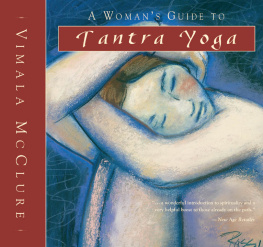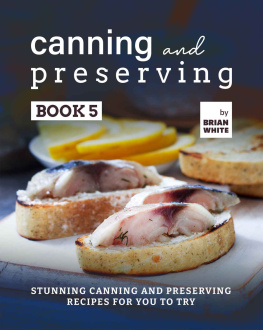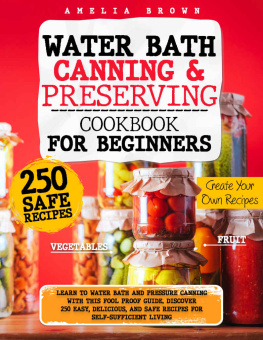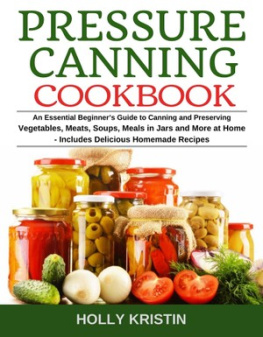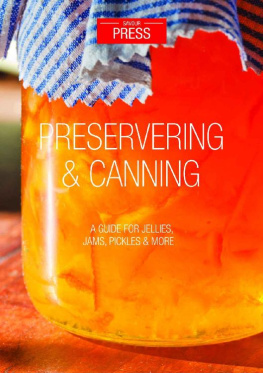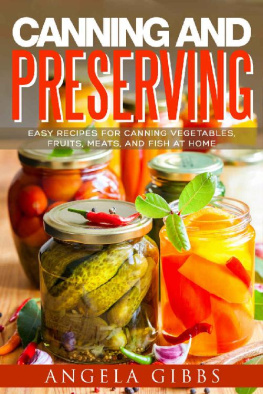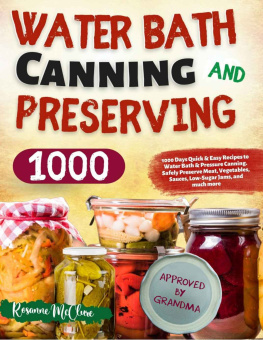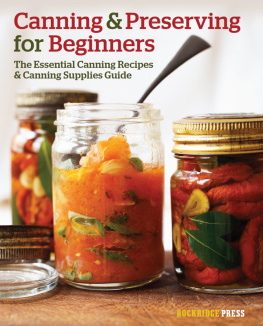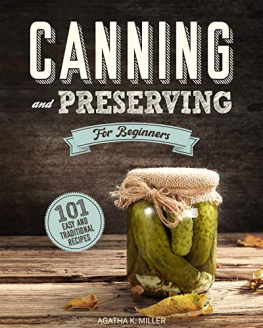Water Bath Canning and Preserving Cookbook for Beginners
1000 Days Quick & Easy Recipes to Water Bath & Pressure Canning. Safely Preserve Meat, Vegetables, Sauces, Low-Sugar Jams and much more
by Rosanne McClure
Copyright 2022 - All rights reserved.
The content contained within this book may not be reproduced, duplicated, or transmitted without direct written permission from the author or the publisher. Under no circumstances will any blame or legal responsibility be held against the publisher, or author, for any damages, reparation, or monetary loss due to the information contained within this book. Either directly or indirectly.
Legal Notice:
This book is copyright protected. This book is only for personal use. You cannot amend, distribute, sell, use, quote or paraphrase any part, or the content within this book, without the consent of the author or publisher.
Disclaimer Notice:
Please note the information contained within this document is for educational and entertainment purposes only. All effort has been executed to present accurate, up to date, and reliable, complete information. No warranties of any kind are declared or implied. Readers acknowledge that the author is not engaging in the rendering of legal, financial, medical, or professional advice. The content within this book has been derived from various sources. Please consult a licensed professional before attempting any techniques outlined in this book. By reading this document, the reader agrees that under no circumstances is the author responsible for any losses, direct or indirect, which are incurred because of the use of information contained within this document, including, but not limited to, errors, omissions, or inaccuracies.
Table of Contents
Table of Contents
Introduction
It is said that cooking food is an art, and you pour all your love into the effort you put into cooking. The food that tastes great touches the heart through the tongues taste. And it is justified to preserve such food and effort for your loved ones for a longer time. That is where canning and preserving the food enters the game.
Cooking is not just meant to keep for yourself. A well-cooked food is meant to reach everyone by canning and preservation. Even you can treat yourself to delicious food for long through rightly preserved food. And canning methods and preserving techniques tend to your need of preserving food. You can even preserve freshly picked vegetables and fruits using precise recipes.
There is no limit to the types of food you can preserve, whether cooked or uncooked. You can save the food for later use with the apt use of spices, preservatives, and well-directed recipes. With an unlimited variety of food come numerous methods of keeping them safe.
You can either store them in jars by canning or simply preserve them with special recipes for preserving. Even canning needs you to experiment with different recipes and techniques to keep the food good to eat for long.
Though the recipes and techniques have been practiced for years, the effort and your remarkable variety can make them taste unique. If you are a cooking enthusiast, canning and preserving techniques are a must for you.
Learn them and practice using your varieties to make good use of your food cooked with effort. Just like something loved is kept safe, cooking lovers find canning and preserving techniques safe for their food.
The methods of canning and preserving are aplenty. And each method gives a unique taste to the food. It is on you to choose whichever way you deem fit. Take pressure canning or water bathing, dehydrating, or fermenting, or smoking; the preserved and canned food will not disappoint you.
This book will teach you all you need to know if you are just beginning at canning and preserving techniques. You must learn along with the guidelines we mention here. Learn these recipes, follow them, and be good as a seasoned cook who knows how to preserve the food.
Chapter 1: - What Is Canning and Preserving?
Canning and preserving are terms that are often interchanged with one another. Basically, both refer to techniques that involve putting food in containers for longer shelf life. Canning is a preservation technique that involves heating food to a high temperature to attenuate harmful microorganisms that cause the food to spoil as well as health problems to people. During the canning method, the food inside the container is heated at extremely high temperatures that result in air being driven out from the can thereby creating a vacuum seal as the container cools. The absence of air improves the shelf-life of food and prevents it from being re-contaminated by microorganisms.
Chapter 2: - The Benefits of Canning and Preserving?
Canning your food has a lot of benefits. Aside from enhancing the shelf life of your food, there are also many advantages to preserving your food using this technique. Below are the benefits of why you need to can your own food:
- A fully stocked pantry: When you can your own food, you also make sure that your pantry is stocked full of food. Having a pantry will a lot of canned foods provide a cushion against the fluctuating cost and supply of foods. As opposed to purchasing speciality foods from gourmet shops, you may also enjoy them and fill your pantry with them without having to spend a lot of money.
- You know what goes into your food: Canning and preserving food is a fantastic choice if you want to have control over what goes into your meals. Unfortunately, many commercial canned foods contain artificial preservatives and other ingredients that you may not approve of.
- Convenient: Having your own stock of canned foods is very convenient. You dont need to go out to buy your food. And during this new normal situation when people are discouraged from going to crowded places such as the grocery stores, having your own food provides health security for the family.
- Save money: Food is one of the essential items that people need for survival. Economic problems, political unrest, and pandemics do not only drive food prices up but also diminishes its supply. Canning and preserving your own food will save you tons of money.
- A fulfilling activity: Making your own food can be a rewarding endeavor. This exercise may be worthwhile for you if you know that you are taking a sustainable action. To make this pastime even more satisfying, enlist the assistance of your family.
Chapter 3: -Canning Process
The previously selected food reaches the packing plant. All foods that are canned necessarily pass physical-chemical and sensory quality control before entering the process. This means, "Only the best products are canned." These foods subjected to a washing process and then peel, cut and sliced, discarding the inedible parts. Immediately afterward, some foods (such as casseroles) are cook just long enough to neutralize the enzymes that could break down the foods. To preserve their flavor and color, others like fruits and vegetables go directly to step five. Food is placed in the cans and sealed to submit them to the thermal sterilization process. The degrees of temperature and the processing times depend on the food and are a function of the high or low acid variables of the product. Finally, the cans are label and stack to be distributed.
Water Bath Canning
Water bath canning is the method of placing food in a water canner, followed by boiling. For this canning process, high-acid food is ideal because most bacteria in such foods can be easily killed by boiling. In this canning method, the required temperature is 100 degrees Celsius and must be maintained throughout the processing period. You must obey the appropriate temperature, or all your energy will be a waste in water bath canning foods. Fruits, sweets, fruit jellies, pickles, preserves, butter, marmalades, acidified tomatoes, and figs are perfect for water bath canning. Choosing the right and new fruit is one consideration in canning foods. Fresh fruits affect your preserved food quality. Until loading into canning pots, fruits must be pre-cooked first. This called the hot pack method, whereas raw or uncooked fruit and vegetables called the cold pack method. Not all vegetables such as tomatoes and figs can be processed in bath-canned water. First, you must put these vegetables in commercial acid before you can bath them. Water bath canning can easily do at home for improvised, simple and cheap equipment in water bath canning. This method is not true because all procedures are easy to follow. Listed below are these simple basic steps to understand this method:


